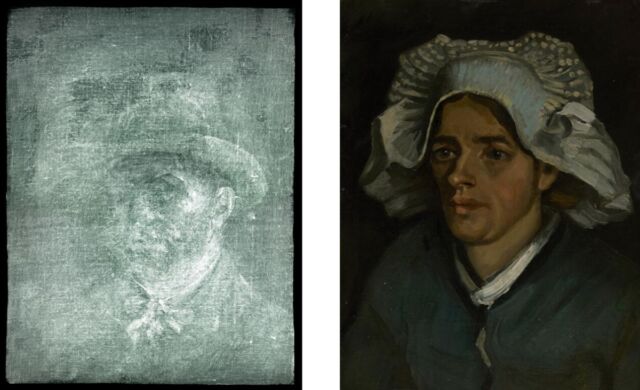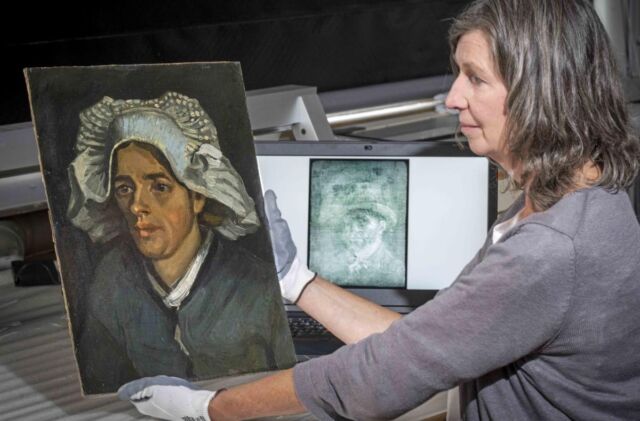

X-rays reveal hidden Van Gogh self-portrait
source link: https://arstechnica.com/science/2022/07/x-rays-reveal-hidden-van-gogh-self-portrait/
Go to the source link to view the article. You can view the picture content, updated content and better typesetting reading experience. If the link is broken, please click the button below to view the snapshot at that time.

Surprise! —
X-rays reveal hidden Van Gogh self-portrait
Self-portrait was hidden for more than 100 years beneath layers of glue and cardboard.
Jennifer Ouellette - 7/18/2022, 4:56 PM
A routine cataloging procedure of a painting by Vincent van Gogh at the National Galleries in Scotland yielded an unexpected discovery: a hidden self-portrait on the back of the canvas. The portrait was revealed while conservationists were conducting an X-ray analysis of Head of a Peasant Woman as part of a cataloging exercise in preparation for an upcoming exhibition. Once the exhibit opens, visitors can view the X-ray image through a specially crafted lightbox at the center of the display.
As I've reported previously, X-ray imaging techniques are a well-established tool to help analyze and restore valuable paintings because the rays' higher frequency means they pass right through paintings without harming them. X-ray imaging can reveal anything that has been painted over a canvas or where the artist may have altered the original vision.
For instance, Vermeer's Girl Reading a Letter at an Open Window was first subjected to X-ray analysis in 1979 and revealed the image of a Cupid lurking under the overpainting. And in 2020, a team of Dutch and French scientists used high-energy X-rays to unlock Rembrandt's secret recipe for his famous impasto technique, believed to be lost to history.
Last year, we reported that researchers used infrared reflectography to peer through the upper layers of paint of the famous 1788 portrait, now housed in the Metropolitan Museum of Art in New York, of the 18h century French chemist Antoine Lavoisier and his wife, Marie-Anne, by Jaques-Louis David. The resulting reflectogram showed evidence of a carbon-based black underdrawing and dark, unclear shapes hinting at possible significant compositional changes. The team also used macro X-ray fluorescence imaging to map out the distribution of elements in the paint pigments—including the paint used below the surface—to create detailed elemental maps for further study.
Nor is this the first time a Van Gogh painting has been subjected to X-ray analysis. Back in 2008, European scientists used synchrotron radiation to reconstruct the hidden portrait of a peasant woman painted by Van Gogh. The artist, known for reusing his canvases, had painted over it when he created 1887's Patch of Grass. The synchrotron radiation excites the atoms on the canvas, which then emit X-rays of their own that a fluorescence detector can pick up. Each element in the painting has its own X-ray signature, so scientists can identify the distribution of each in the many layers of paint.
AdvertisementVan Gogh was also known to reuse a canvas by painting on the reverse side. As Van Gogh expert Martin Bailey writes in The Art Newspaper:
The Edinburgh painting is not van Gogh’s only double-sided painting with reused canvas. In 1929, the Dutch conservator Jan Cornelius Traas removed cardboard backing from three Nuenen paintings, revealing hidden portraits on the reverse. And we can report that it has long been suspected that there could be something on the hidden side of Head of a Peasant Woman.
Completed in May 1885, Head of a Peasant Woman is one of Van Gogh's more modest efforts, and it was donated to the National Galleries in 1960 by an Edinburgh lawyer named Alexander Maitland. According to the museum, experts now believe it's part of a series of studies Van Gogh made in connection with a larger painting, The Potato Eaters (currently housed at the Vincent van Gogh Museum in Amsterdam), completed in May 1885.
The museum's conservationists weren't expecting much when they subjected the small painting to X-ray analysis. The resulting X-ray image revealed a portrait of a bearded sitter in a brimmed hat with a neckerchief loosely tied at the throat, looking very much like Van Gogh. The portrait had been covered by layers of glue and cardboard, most likely applied in the early 20th century, possibly to secure the painting more secure before framing it for an exhibition.
"Lo and behold! We don't see much of the peasant woman, but what we have is the lead white, the much heavier pigment he used for his face, showing up after the X-ray goes through the cardboard," Lesley Stevenson, senior paintings conservator at the National Galleries of Scotland, told the Guardian. "The discovery of a new work is extraordinary. Anything that gives us more information about the artist is a huge bonus and just shows the benefit of technological analysis, that we can still find out new things."
The next step is to figure out how to remove the layers of glue and cardboard covering the self-portrait without damaging the other painting. It's unclear what condition the self-portrait is in more than a century later. "It's like stepping into the unknown," Stevenson told the Guardian. "The challenge will be removing the adhesive from the oil paint layers, exploiting the difference in solubility of animal-based glue and oil-based paint."
Listing image by Neil Hanna
Recommend
About Joyk
Aggregate valuable and interesting links.
Joyk means Joy of geeK

